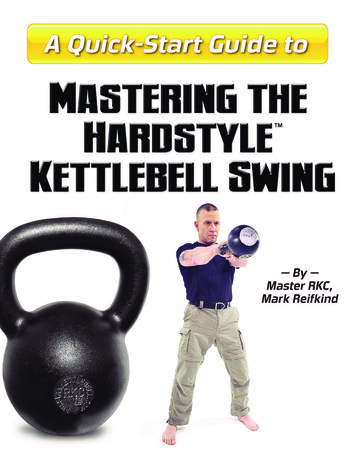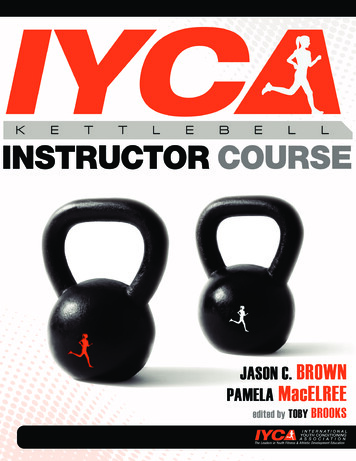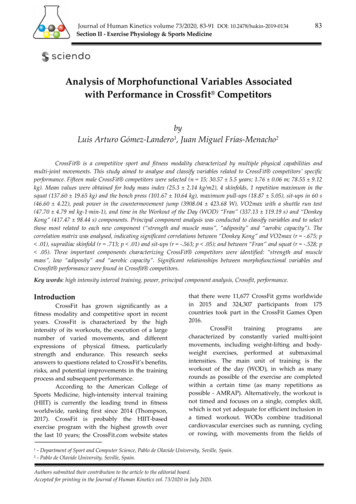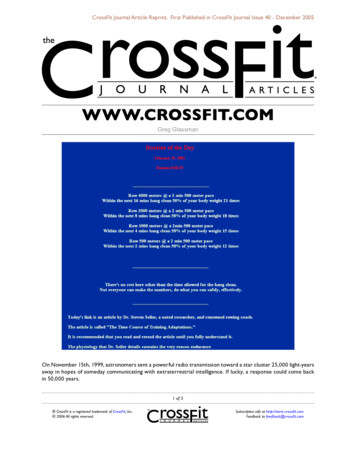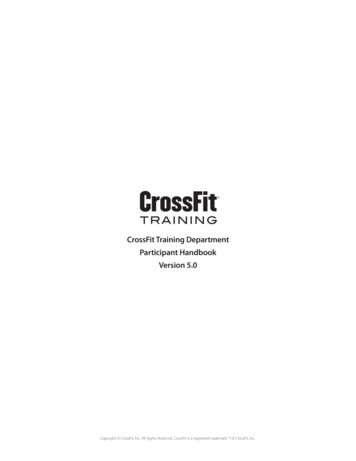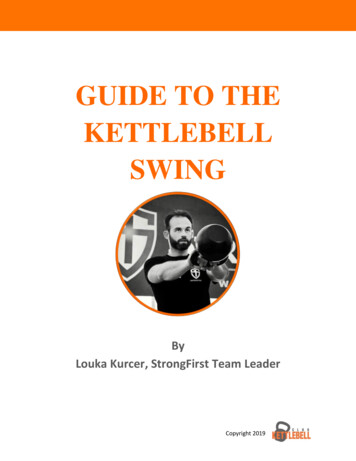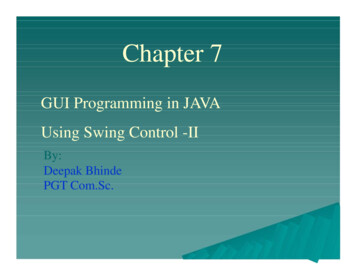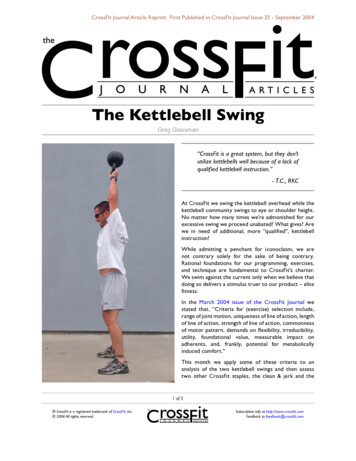
Transcription
CrossFit Journal Article Reprint. First Published in CrossFit Journal Issue 25 - September 2004The Kettlebell SwingGreg Glassman“CrossFit is a great system, but they don’tutilize kettlebells well because of a lack ofqualified kettlebell instruction.”- T.C., RKCAt CrossFit we swing the kettlebell overhead while thekettlebell community swings to eye or shoulder height.No matter how many times we’re admonished for ourexcessive swing we proceed unabated? What gives? Arewe in need of additional, more “qualified”, kettlebellinstruction?While admitting a penchant for iconoclasm, we arenot contrary solely for the sake of being contrary.Rational foundations for our programming, exercises,and technique are fundamental to CrossFit’s charter.We swim against the current only when we believe thatdoing so delivers a stimulus truer to our product – elitefitness.In the March 2004 issue of the CrossFit Journal westated that, “Criteria for (exercise) selection include,range of joint motion, uniqueness of line of action, lengthof line of action, strength of line of action, commonnessof motor pattern, demands on flexibility, irreducibility,utility, foundational value, measurable impact onadherents, and, frankly, potential for metabolicallyinduced comfort.”This month we apply some of these criteria to ananalysis of the two kettlebell swings and then assesstwo other CrossFit staples, the clean & jerk and the1 of 5 CrossFit is a registered trademark of CrossFit, Inc. 2006 All rights reserved.Subscription info at http://store.crossfit.comFeedback to feedback@crossfit.com
The Kettlebell Swing (continued.)“thruster” for comparison and further elucidation ofour thinking in selecting exercises for regular inclusionin our program.Examining why we’ve rejected the shorter, “Russian”,swing, and adopted the longer, “American”, swing offersan opportunity to examine and share the thinking thatis part and parcel of the CrossFit method.A little background is in order. The modern era ofthe kettlebell is largely the work of Russian émigré,Pavel Tsatsouline. Long ignored in the West, kettlebelltraining has a long and distinguished history in Russiahttp://www.cbass.com/Kettlebell.htm.At CrossFit the rise of the kettlebell movementwas cause for excitement. The kettlebell itself wassomewhat unfamiliar; the kettlebell movements we’dlong known from their dumbbell analogs, but Mr.Tsatsouline brought something more important thanthe kettlebell or kettlebell movements to the U.S. Hecame with a forceful and compelling rationale for highrep weightlifting in elite strength and conditioning.Understanding the unique potential of high repweightlifting puts the kettlebellers and CrossFittersin rare company. Whatever else distinguishes ourapproaches this commonality is more important thanour differences. Our two communities are, in ouropinion, separated more by the number of tools we usethan anything else.On first being introduced to the kettlebell swing ourimmediate response was, “Why not go overhead?”Generally, we endeavor, somewhat reflexively, tolengthen the line of travel of any movement. Why?There are two reasons. The first is somewhat intuitive.We don’t do half rep pull-ups, we don’t do half rep squats,and we don’t do half rep push-ups. If there is a naturalrange of motion to any movement we like to completeit. To do otherwise seems unnatural. We would arguethat partial reps are neurologically incomplete. Thesecond reason deals with some fundamentals of physicsand exercise physiology.From physics we know that the higher we liftsomething, and the more it weighs, the more “work”we are performing. Work is in fact equal to the weightlifted multiplied by the height we lift the object. Workperformed divided by the time to completion is equalto the average “power” expressed in the effort.“Russian Swing”2 of 5 CrossFit is a registered trademark of CrossFit, Inc. 2006 All rights reserved.Subscription info at http://store.crossfit.comFeedback to feedback@crossfit.com
The Kettlebell Swing (continued.)Power is exactly identical to the exercise physiologist’s“intensity”. Intensity, more than any other measurablefactor, correlates to physiological response. So morework in less time, or more weight moved farther in lesstime, is largely a measure of an exercise’s potency.When we swing the kettlebell to overhead, theAmerican swing, we nearly double the range of motioncompared to the Russian swing and thereby double thework done each stroke. For any given time period, thepower would be equivalent only if the Russian swingrate was twice the American swing rate.In fact, “T.C.”, the gentleman who decried our lack of“qualified” instruction, recently claimed, “you will beable to get two low swings in for every one overhead.”Were this true, and all other things equal, the twoswings would require equal power to perform andconsequently be similar in effect.We have, however, tested the “period”, or time tocomplete each swing, for both the American and Russianmethods and we’ve found that the American swingrather than being half the rate of the lower Russianswing was closer to eighty-five percent of the Russianswing. This would require that the advocates of thelower, shorter, Russian swing perform the movementwith nearly twice the load to improve on the power ofthe American swing. We don’t think that is very likely tooccur. Most of our guys can swing the 2-pood (32 kg or70.5lb) to overhead with control and precision.After measuring the swing height and displacementfor both the American and Russian swings we hadseveral athletes swing 1.5 pood kettlebells, countingthe repetitions, for one minute employing the Russianmethod. After an extended rest, we repeated the testwith the same size kettlebells while employing theAmerican swing. What we found was that the Russianswing demanded only sixty-five percent of the powerrequired of the American swing - hardly close.Power a measure of intensity can certainly be perceived,and it is the perception of all our athletes who havetried both swings that the longer American swing issubstantially harder than the shorter Russian swing.Many offered, “it’s twice as hard”.Curious about other physiological measures we repeatedthe tests with a downloadable heart rate monitor. Heartrate being a reliable correlate of power or intensity, we’dexpect the American swing to generate higher heart“American Swing”3 of 5 CrossFit is a registered trademark of CrossFit, Inc. 2006 All rights reserved.Subscription info at http://store.crossfit.comFeedback to feedback@crossfit.com
The Kettlebell Swing (continued.)NaturalFrequency(reps/min)Range of Motion(feet/reps)Velocity(feet/min)Load requiredto match Power(pounds)Average Power(footxpounds/min)American Kettlebell Swing406.5260X260XRussian Kettlebell Swing473.251531.7X260XBarbell Thruster383.251242.1X260XBarbell Clean & Jerk186.51172.22X260XExerciserates compared to the Russian method. Consistent withour calculations and our athlete’s perceived exertion,the heart rates recorded while employing the Americanswing averaged nearly twentyfive beats per minutehigher than recorded employing the Russian swing.We analyze most of our exercises in this way. Verticaldisplacement, load, and period or rate of repetition arecritical to measuring power or determining intensityand, collectively with heart rate and perceived exertion,lend themselves to our determination of whether anexercise is worthy of regular inclusion in our workouts.On this basis alone, the half or Russian kettlebell swingdoesn’t make the cut.In examining the mechanics and physics of exercises it isreadily apparent that range of motion or line of actionare fairly fixed. What is less apparent but generally thecase is that our exercises also have a natural period orfrequency of repetition.“Russian Swing”“American Swing”4 of 5 CrossFit is a registered trademark of CrossFit, Inc. 2006 All rights reserved.Subscription info at http://store.crossfit.comFeedback to feedback@crossfit.com
The Kettlebell Swing (continued.)The natural frequency or period of an exercise canbe found by performing it deliberately and quicklywith an insignificant load. As we gradually increase theload what we see is that the period long remains fixeduntil, eventually, sufficient load slows the movementprecipitously. The rate of performance prior to thisthreshold is the natural period or frequency of themovement.We’ve seen videotape where U.S. Olympic weightlifterShane Hamman is juxtaposed side by side clean andjerking both an empty bar and eighty percent of his max.The two movements are in perfect synch. The clean andjerk like many exercises has a natural period.From watching videotape we’ve determined the naturalfrequency of the American kettlebell swing, the Russianswing, the thruster, and clean and jerk.For the Russian Swing this rate is forty-seven strokesper minute, for the American swing it was forty, for the“thruster” (front squat/push-press) thirtyeight, and forthe “touch and go” clean and jerk it was 18 strokes perminute.Similarly, we analyzed the range of motion for thesemovements and found that the Russian kettlebell swingand thruster both traveled about three and a quarterfeet and that the American swing and clean & jerk bothtraveled about six and one half feet. All of these measureswere averaged from two male athletes standing nearlysix feet tall.Knowing the range of motion and natural period ofthese exercises we can determine what loads would berequired to produce equivalent expressions of poweramong the four exercises. The answers are revealing.Using this information we can show that the Russiankettlebell swing would have to be performed withloads nearly twice that of the American swing to exactsimilar power and intensity demands. This may not bepossible.In the case of the thruster and the clean & jerk the loadswould have to be a little over twice as large and this isreadily doable.Indeed, it is our considered opinion that the Russiankettlebell swing becomes too heavy before it approachesthe power of our preferred American kettlebell swingand that the thruster and clean and jerk are both vehiclesfor outpacing the power demands of the Americanswing. Physical analysis, measured heart rates, observedimpact, and our athlete’s perceived exertion supportthese contentions beautifully.Greg Glassman is the founder (with LaurenGlassman) of CrossFit, Inc. and CrossFit SantaCruz and is the publisher of the CrossFit Journal.He is a former competitive gymnast and hasbeen a fitness trainer and conditioning coachsince the early 1980s.5 of 5 CrossFit is a registered trademark of CrossFit, Inc. 2006 All rights reserved.Subscription info at http://store.crossfit.comFeedback to feedback@crossfit.com
The Kettlebell Swing Greg Glassman “CrossFit is a great system, but they don’t utilize kettlebells well because of a lack of qualified kettlebell instruction.” - T.C., RKC At CrossFit we swing the kettlebell overhead while the kettlebell community swings to eye or shoulder

